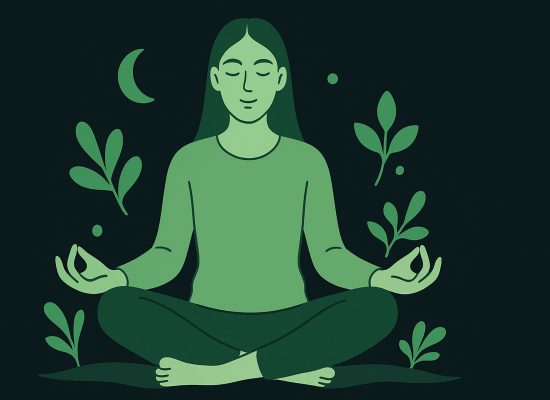If you’re new to meditation, it can feel daunting to know where to start. However, meditation isn’t as intimidating as it seems. With handheld devices and the internet playing a significant role in our daily lives, we have the perfect opportunity to meditate right at our fingertips. If you’re wondering how to meditate, you’re not alone. Many beginners feel unsure where to start, but the good news is that meditation is simple and accessible. Whether you want to reduce stress, improve focus, or just take a moment for yourself, this guide will show you the best way to meditate, step by step. This guide will walk you through how to meditate effectively as a beginner.
Table Of Content
- What is Meditation? Understanding the Basics
- How to Do Meditation: A Step-by-Step Guide for Beginners
- What is the Best Way to Meditate? Finding the Right Method for You
- Starting Your Practice: The Best Way to Meditate and Build a Routine
- Overcoming Meditation Challenges
- Start Today with Siddha Meditate
- FAQ about How to Meditate?
What is Meditation? Understanding the Basics
Meditation is an ancient practice dating back thousands of years. Although it started as a spiritual tradition, it is now a widespread tool used for reducing stress and improving overall wellbeing. In the last decade, there has been a significant increase in high-quality research to show the benefits of meditation. Research continues to show that even a few minutes of daily meditation can improve emotional resilience and cognitive function. According to a 2023 study from Johns Hopkins University, meditation may be as effective as antidepressants in managing anxiety and depression. Neuroscientists have also found that meditation rewires neural pathways, making it easier to regulate emotions and improve focus over time.
Meditation has been shown to support a range of conditions for mental and physical health. Harvard Health explains that a regular meditation practice can alter the brain’s response to anxiety and depression by improving focus, which helps redirect attention away from intrusive and negative thought patterns. Meditation also has physical benefits like improving sleep, lowering blood pressure, improving the immune function, and relieving discomfort from chronic pain and autoimmune disorders.
The best way to meditate is by starting simple. You can begin with a 5 minute guided mindfulness meditation to focus your attention on the present moment. This may be done by focusing on the breath, a sensation in the body, or cultivating appreciation for something you’re grateful for. There are a range of meditations for all levels available at the tips of our fingers. The most important thing is finding the one that works for you and staying consistent. Now you’re ready to find out how to meditate for the first time.
How to Do Meditation: A Step-by-Step Guide for Beginners
- Settle into wherever you are.
Before we dive in, let’s cover the basics of how to do meditation in a way that fits your lifestyle. You don’t need a silent retreat or hours of free time—just a few minutes to reconnect with yourself. Meditation doesn’t require a lot of time or a quiet space—you can practice wherever you are. You can meditate in your car before entering the workplace, on a break at your workplace, or on public transport on the way home from a busy day. All it takes is putting on headphones, turning on a guided meditation, and softening your gaze to connect to your inner self.
2. Check in with yourself.
Give yourself a mindful moment to become aware of your external and internal environment. Notice how you’re feeling physically, mentally, and emotionally. Take a moment to pause and notice how your body feels. Is your jaw clenched? Are your shoulders tense? Simply becoming aware of these small details can help you reset and soften into the practice. If your thoughts feel scattered, remind yourself that you don’t need to “clear your mind”—you just need to be present.
3. Connect to your breath.
Become aware of the natural flow of your breath and start to intentionally deepen your breath. To bring your body to a state of ease, you can try elongating your exhales.
4. Notice the thoughts.
Meditation is an opportunity to become aware of your natural thinking patterns. When you become aware of your thoughts, you can develop a stronger relationship with yourself and reduce anxiety.
5. Give yourself compassion.
If you catch yourself replaying past situations, obsessing over work, or judging yourself, meditation can help you get out of the negative cycle and cultivate self-compassion.
6. Make distraction your friend.
The meditation actually begins when you first notice that your mind is wandering. Meditation is a practice, meaning you may have to redirect distracting thoughts many times throughout. This is where your breath becomes a powerful tool. By consciously reminding yourself to breathe and paying attention to where you feel it in your body, you can bring yourself back to the present moment.
7. Close it out.
If you are doing a nighttime meditation, let the meditative focus go and drift off to sleep. If you are starting your day or performing a mid-day practice, softly reopen your eyes and integrate the experience back into your day.
What is the Best Way to Meditate? Finding the Right Method for You
There’s no single “best” way to meditate—what works for one person may not work for another. Here are some popular meditation styles to help you choose:
- Mindfulness Meditation: Focuses on breath and body awareness. Great for stress relief.
- Guided Meditation: Uses an instructor or app to lead you. Perfect for beginners.
- Loving-Kindness Meditation: Focuses on compassion and positive emotions.
- Body Scan Meditation: Helps with relaxation and sleep.
The best way to meditate is the one that fits your lifestyle and feels natural to you. Experiment with different styles to find what resonates most.
Starting Your Practice: The Best Way to Meditate and Build a Routine
Setting Realistic Goals
As a beginner, it’s important to set realistic expectations. Meditation can be difficult at first, especially when your mind is full of noisy, distracting thoughts. However, with consistent practice, you’ll notice gradual improvements in your ability to stay present and calm. Studies suggest that it takes at least 2-4 weeks of daily 10-minute practice to notice improvements in focus, mood, and overall wellbeing. To see noticeable improvements, commit to 8 weeks of regular practice. If you start now and commit to a routine, you’ll soon experience the positive changes firsthand.

How to do Meditation Consistently
To use meditation as a tool for stress reduction, it’s important to make it a daily habit. The best way to meditate consistently is use your phone for guided meditations. Start with scheduling out the meditations for the week using the Siddha Meditate App. Struggling to stay consistent? Try habit-stacking—pairing meditation with something you already do daily. For example, meditate right after brushing your teeth or before checking your morning emails. This makes it easier to turn meditation into an effortless habit rather than something you “have to” remember. You may start with 5 minute practices, and work yourself up to 15 minutes overtime. You can keep track of your progress on the app.
Overcoming Meditation Challenges
Meditation Myths
One of the most common misconceptions about meditation is that you’re supposed to have no thoughts at all. Many beginners expect their minds to instantly go quiet, and when they inevitably experience thoughts, they feel discouraged. In reality, having thoughts during meditation is normal. The goal isn’t to eliminate thoughts, but to notice them without getting caught up in them. Meditation is a practice, not a performance, and it’s natural for your mind to wander.
Making Friends with Distractions
It’s common to struggle with distractions, especially when you’re new to meditation. Instead of fighting distractions, welcome them as part of your practice. If a noise pulls your attention, try labeling it—“That’s the sound of a car passing”—and return to your breath. If a thought arises, acknowledge it without judgment, and gently refocus. Every time you do this, you’re strengthening your mental muscles for focus and calm.
Learning how to meditate with distractions can help strengthen your focus over time. When your mind starts to wander, direct your focus to where you feel your breath in the body. Take a few deeper breaths and repeat in your mind “I am breathing in, I am breathing out.” Remember, the goal isn’t to stop thinking but to observe the thoughts without attachment.
Can’t Sit Still? How to do Meditation With Movement
Not everyone finds stillness in the same way. Some people feel more relaxed while moving—and that’s okay! If sitting feels uncomfortable, try walking meditation, stretching, or even mindful dancing. The key is to bring your attention to the present moment, no matter what position you’re in.
Practicing meditation while walking or standing can be a great way to still prioritize your practice if you have trouble sitting still. You don’t have to be in a traditional seated posture to meditate. You can also incorporate your practice while sitting at your work desk with a short body scan or lying down in bed before falling asleep.

How to Meditate When You Don’t Have Time
If you struggle to find time to meditate, consider incorporating and scheduling short sessions into your calendar. Instead of scrolling on your phone or social media, try meditating. You can even meditate while commuting, waiting in line, or during a quick work break. Meditation doesn’t require dedicated time; you can replace other less productive habits with a short guided meditation.
To redirect urges and make better use of your time, try this simple trick: whenever you feel the impulse to pick up your phone and mindlessly scroll through social media, use it as a cue to do a short meditation on your phone instead.

Start Today with Siddha Meditate
The best way to meditate is to start today with the Siddha Meditate app! Siddha offers a variety of meditations right at your fingertips. You can begin your meditation journey today by visiting our meditation page and scheduling any of these tailored practices to fit your needs, right into your calendar with just a click.
- For Relaxation: Breath Awareness Meditation
- For Focus: Mindfulness Meditation
- For Compassion: Loving-Kindness Meditation
Sign up using your 7 day free trial and start meditating today!
FAQ about How to Meditate?
1. What is the best way to meditate for beginners?
For beginners, the best way to meditate is to start with simple practices that fit easily into your daily routine. Begin by finding a comfortable position, whether sitting or lying down, and focus on your breath. Guided meditations can be particularly helpful, providing step-by-step instructions to keep you on track. Consistency is key; even dedicating just 5 minutes a day can lead to noticeable benefits over time. Remember, meditation is a personal journey, so explore different techniques to discover what resonates best with you.
2. How do I meditate if I can’t sit still?
If sitting still is challenging, consider incorporating movement into your meditation practice. Walking meditation, for example, allows you to focus on the sensation of movement and your surroundings. Alternatively, practices like yoga or tai chi combine physical activity with mindfulness, helping to channel restless energy constructively. The goal is to bring your attention to the present moment, regardless of the activity, making meditation accessible even for those who find stillness difficult.
3. How can I make meditation a daily habit?
To make meditation a consistent part of your daily routine, start by setting realistic goals. Begin with short sessions, such as 5 minutes each day, and gradually increase the duration as you become more comfortable. Incorporating meditation into existing routines, like practicing mindfulness during your morning coffee or before bedtime, can also be effective. Utilizing meditation apps that offer guided sessions and reminders can provide structure and support, helping you stay committed to your practice.
4. What should I do if my mind keeps wandering during meditation?
It’s natural for the mind to wander during meditation, especially for beginners. When you notice your thoughts drifting, gently redirect your focus back to your breath or chosen point of attention without judgment. This process of noticing and refocusing is a fundamental aspect of meditation and becomes easier with practice. Remember, the goal isn’t to eliminate thoughts but to develop a mindful awareness of them, enhancing your ability to stay present over time.







2 Comments
Comments are closed.